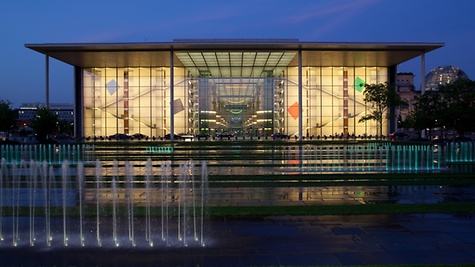Navigationspfad: Homepage > Art and History > Art > Artists
Ellsworth Kelly
"Berlin Panels 2000", west facade of the Paul Löbe Building
Ellsworth Kelly is one of the best-known artists associated with ‘hard-edge painting’. In 2013, he was awarded the National Medal of Arts by President Barack Obama. This level of appreciation is reflected, too, in the fact that he was asked in 2008 to create a 12-metre-high stainless steel column for the central courtyard of the US Embassy in Berlin – the Berlin Totem. Ellsworth Kelly also created a prominent installation for the German Bundestag: the Berlin Panels 2000. These four aluminium objects in blue, black, red and green are plainly visible through the glazed west facade of the Paul Löbe Building, where the clearly delineated colour fields strike a distinctive note.
Ellsworth Kelly belonged to a generation of post-war artists in the US who sought to achieve a form of art liberated from European traditions. The ‘NewYork School’, with painters like Jackson Pollock, Robert Motherwell, Mark Rothko, Barnett Newman and Ad Reinhardt, founded the abstract expressionism movement, as well as the hard-edge painting movement. Ellsworth Kelly, on the other hand, shaped by six years of study in France, was interested in the development of abstraction in Europe, absorbing influences from Kazimir Malevich and Paul Klee, Constantin Brancusi, Hans Arp and Sophie Taeuber-Arp, and developing his concept of ‘impersonal observation of form’. He began by making precise line drawings of plants and then one day discovered a window in a museum, which he recreated in his atelier, reduced to its basic outlines, as a painted relief. Thus, the artwork Window, Museum of Modern Art, Paris (1949), which would later be seen as central to his work, was born.
He subsequently used such fragments from everyday reality to develop simple large geometric shapes – whether as canvases, reliefs or sculptures – with clearly delineated and often curved edges and colourful monochrome surfaces. These objects are based on forms found in nature, yet they are so radically abstract that they neither depict reality nor express anything subjective: they are simply symbolic objects of form and colour.
Works consisting of several objects, such as the Berlin Panels 2000, follow this logic, made up of autonomous individual forms confirming their independence – with no intention of creating meaning or reference – through repetition in various colours. At the same time, the wall, as the medium physically supporting the pictorial elements, becomes part of the installation and also part of the ‘pictorial space’.
This effect is heightened by the fact that the observer repeatedly sees all four elements and compares the forms oft he four diamond-like panels with each other. They appear almost identical. Yet, in reality, the internal angles of these ‘diamond shapes’ vary slightly. Kelly scattered the four colourfields across the facade in an elegant dance-like rhythm,where they create an interplay with the lines of the building’s stairs. In this way, his installation, in which any kind of “hierarchy has been eroded and replaced by a democracy of unlimited opportunities” (Georg Imdahl), prepares people for the free and vibrant spirit of the building. Visitors who pass the Berlin Panels 2000 and enter the Paul Löbe Building then see four illuminated neon tubes suspended below the roof, which were created by French artist François Morellet. They are autonomous objects of colour and form, providing a congenial variation on Ellsworth Kelly’s concept.
Ellsworth Kelly
born in 1923 in Newburgh, Orange County, NewYork; died in 2015 in Spencertown, New York
Written by: Andreas Kaernbach, Curator of the Art Collection of the German Bundestag









